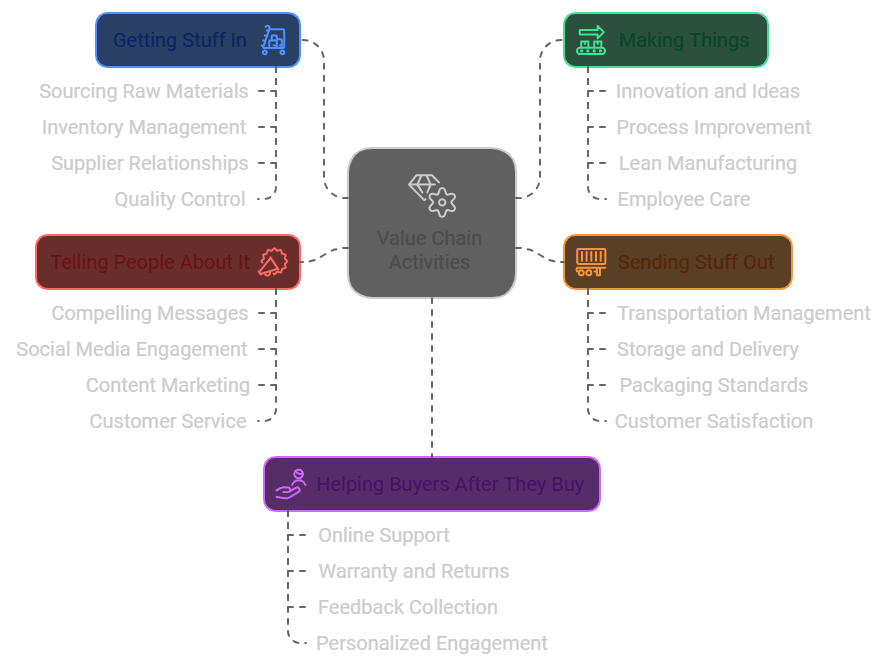Key Activities for Creating Value
Creating value is important for any business or organization. Specific activities are significant in this process. By focusing on these activities, companies can improve their offerings, increase customer satisfaction, and enhance their bottom line. Whether it’s through innovation, efficiency, or customer engagement, the actions taken to create value are crucial for sustained success in the competitive marketplace.
Understanding and implementing these activities is vital for any business looking to thrive in today’s economy.
Understanding How Value Chains Work
Michael Porter’s value chain consists of several primary activities:
- Inbound logistics.
- Operations.
- Outbound logistics.
- Marketing and sales.
- Service
These activities work together to optimize the production process, from sourcing raw materials to delivering the final product to the customer.
This process ensures that each step adds value and keeps costs in check. As a result, companies gain a competitive advantage and higher profits. Companies can optimize each activity to improve the value chain, use innovation to enhance efficiency and invest in technology. Conducting a value chain analysis helps identify areas for improvement and guides resource investment to enhance product or service quality and efficiency.
The Parts of a Value Chain

Getting Stuff In
Businesses need to consider several factors for effectively managing inbound logistics in a value chain. This involves carefully sourcing and storing raw materials to ensure a smooth and efficient supply chain. Streamlining procurement processes and negotiating favorable terms with suppliers are also crucial for gaining a competitive edge. Leveraging technology for inventory management and automating tasks can enhance efficiency and reduce operational costs and time.
Just-in-time inventory management and building strong relationships with reliable suppliers can also improve the quality and timeliness of inbound logistics. Implementing stringent quality control measures and optimizing transportation routes are essential for maximizing value within a value chain. By focusing on these considerations, businesses can strengthen their position in the industry and drive higher profits through effective inbound logistics practices.
Making Things
Companies can create new ideas and solve problems through brainstorming sessions, workshops, and employee feedback systems. This encourages a culture of innovation and creativity. Market research, competitor analysis, and customer feedback provide valuable insights for generating new ideas and solving problems.
Continuous process improvement, automation, and cutting-edge technology can ensure efficient systems for making things. Implementing lean manufacturing principles, optimizing workflow layouts, and investing in employee training are effective methods for ensuring smooth and efficient production processes.
Caring for employees involves providing a safe and comfortable work environment, competitive wages and benefits, and promoting a healthy work-life balance. Offering opportunities for career growth, recognizing employee contributions, and fostering a positive company culture are also essential ways to support employees.
Sending Stuff Out
Businesses use methods like outbound logistics, marketing, and sales to send products to customers or other businesses.
These methods include managing transportation, storage, and delivery of finished goods. Businesses can implement quality control processes and packaging standards to ensure items are packaged and shipped without damage.
Efficient inventory management systems, advanced shipping technologies, and effective relationships with logistics partners help businesses track and manage product sending for timely delivery and customer satisfaction.
These strategies lead to improved customer service and increased competitive advantage.
Telling People About It
Businesses communicate the value of their products or services to potential customers or clients through marketing and sales activities. This includes creating compelling messages, advertisements, and promotions that highlight the offering’s benefits and features.
Companies also use social media, content marketing, and email campaigns to engage with their target audience. By interacting with potential customers and providing valuable content, businesses can showcase the value of their products or services.
Excellent customer service and support further convey the value of the offering, demonstrating a commitment to customer satisfaction.
These strategies help businesses create a competitive advantage and build strong relationships with their customer base.
Helping Buyers After They Buy
Businesses can support buyers after a purchase in a few different ways. They can offer online customer support, provide warranty and return information, and gather feedback through surveys. Addressing any issues or questions after a purchase is also important. Businesses can do this through customer service hotlines, chat support, email assistance, or FAQ sections. Proactively engaging with buyers after a purchase can build loyalty and encourage repeat business.
This can be done through personalized thank you emails, exclusive discounts on future purchases, or product update emails. These strategies can help build a strong relationship with buyers and lead to repeat business and positive word-of-mouth advertising.
The Help You Need to Make Value

Buying What You Need to Make Stuff
Creating a product requires identifying and acquiring the necessary materials and supplies. This can include raw materials, components, and other items needed for production. For instance, a furniture manufacturer needs wood, fabric, and other materials.
Companies can establish relationships with reliable suppliers and vendors to source and acquire components and resources effectively. This could involve negotiating contracts, setting up regular deliveries, and exploring different sourcing options. For example, a clothing retailer might work with multiple suppliers and manufacturers.
When purchasing materials, it is important to consider cost, quality, and reliability factors. Companies should find the right balance between cost-effectiveness and quality to avoid compromising the end product. For instance, a food manufacturer may prioritize high-quality ingredients while seeking cost-effective sourcing options to maintain competitive pricing.
Creating New Ideas and Fixing Problems
Michael Porter’s value chain outlines four primary activities for value creation. These activities are:
- Inbound logistics.
- Operations.
- Outbound logistics.
- Marketing sales, and service
These activities are crucial for generating new ideas and solutions to fix problems within a value chain.
For example, a company can use inbound logistics to streamline the sourcing and transportation of raw materials, leading to cost savings and improved efficiency.
Companies can conduct thorough value chain mapping to integrate new ideas and problem-solving techniques. This involves visually identifying all the steps and activities involved in delivering a product or service and seeking opportunities for improvement.
Companies can pinpoint innovation and process optimization areas by analyzing each value chain node. Successful implementation of new ideas and problem-solving strategies within a value chain can be seen in various industries. For example, a retail company may enhance its outbound logistics by implementing a more efficient distribution system, resulting in quicker delivery times and improved customer satisfaction. Similarly, a manufacturing company may optimize its operations by adopting new technologies and automation, leading to increased productivity and higher-quality products.
Taking Care of The People Who Work For You
To make sure employees are happy and healthy, companies can:
- Offer competitive pay and benefits.
- Focus on work-life balance.
- Provide chances for career growth.
For instance, flexible schedules, wellness programs, and mental health resources can boost overall well-being.
Investing in training, mentorship, and continuous learning supports professional development.
Creating a positive work environment involves open communication, teamwork, and recognizing contributions.
Policies prioritizing diversity, equity, and inclusion can foster a supportive workplace.
All these strategies help keep employees satisfied, engaged, and motivated.
Building Systems for Everything to Work Well
Building systems to ensure everything runs smoothly within a company’s value chain involves strategic planning and implementing different activities. These activities include inbound logistics, operations, outbound logistics, marketing and sales, and service, which are the primary components of Michael Porter’s value chain.
For example, this involves efficiently sourcing raw materials, organizing production processes, and effectively marketing and delivering the final product to the customer.
Businesses must also focus on secondary activities such as procurement, human resource management, infrastructure, and technological development. For instance, an effective HR management system can ensure the right talent is hired and trained to enhance the overall value-creation process.
These systems’ interconnectedness and effective functioning are crucial to optimizing value creation. By mapping the value chain and identifying each step of the process, businesses can evaluate and enhance the interconnectedness of these activities to ensure smooth operations and optimize value creation.
For instance, effective technological development can streamline various processes within the value chain, resulting in higher efficiency and value creation.
How to Make Your Value Better
Improving production processes and adding value involves several steps.
First, invest in advanced technology and automation to streamline operations and minimize errors.
Second, rigorous quality control measures and continuous improvement programs should be implemented to identify and rectify inefficiencies.
Finally, train and empower employees to take ownership of their work and make informed decisions for a more efficient and value-driven production process.
Leverage marketing and sales strategies to effectively communicate the benefits and value of products or services.
Use social media and digital marketing platforms to reach a wider audience and engage potential buyers.
Additionally, emphasize the unique features and benefits of the products or services through compelling storytelling and customer testimonials to convey the value proposition.
Providing ongoing support and assistance to customers is essential.
This can be achieved through responsive customer service and after-sales support, addressing any queries or issues promptly and efficiently.
Offer warranties, maintenance services, and regular product updates or upgrades to demonstrate the company’s commitment to customer satisfaction and value enhancement.
Learning From Examples
Studying successful manufacturing, retail, and technology value chains can provide important insights. For instance, examining the value chain of a thriving e-commerce company like Amazon can teach ways to improve inbound logistics and customer service. Learning from these examples can help businesses find areas for improvement in their value-creation process, making operations more efficient and cost-effective.
Also, studying value chains can help businesses see how different operational activities are connected, from procurement to marketing and sales. This big-picture view lets companies identify bottlenecks, redundancies, or missed opportunities, leading to smoother and more synchronized operations. In the end, learning from examples of value chains can be a useful tool for continuous improvement and maintaining a competitive edge in the market.
Connecting Everything Together
Connecting its different parts can improve the value chain and ensure smooth and efficient operations.
For example, a company can use technologies to track inventory and production in real time, allowing seamless communication between suppliers and manufacturers.
Additionally, a centralized data system can be implemented to share information on consumer demand. This helps in making quick adjustments in production and distribution.
Departments and partners can establish effective communication and coordination using collaborative software and regular meetings. These allow for discussing challenges and opportunities in the value chain.
Strategies to integrate various aspects of value creation could include streamlining the supply process, employing lean manufacturing principles, and optimizing distribution channels to minimize costs and reduce lead times.

Vizologi is a revolutionary AI-generated business strategy tool that offers its users access to advanced features to create and refine start-up ideas quickly.
It generates limitless business ideas, gains insights on markets and competitors, and automates business plan creation.


